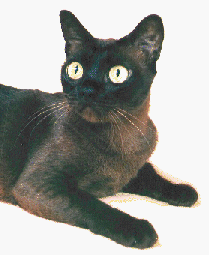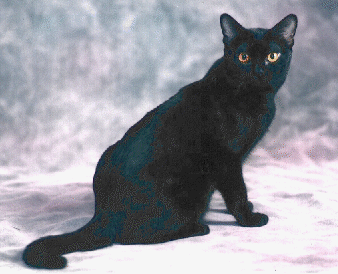
Special FX Olivette
Olivette is a Sable Burmese/Bombay variant.
photo: David Thomas
 SGC Annbirwaves
Midnite Raider
SGC Annbirwaves
Midnite RaiderThe Bombay is a shorthair breed of domestic cat, closely related to the Burmese. The Bombay is noted for its shiny black coat and copper eyes and for its affectionate and playful temperament.
The Bombay was developed by Nikki Horner, a breeder in Louisville, Kentucky. She set out to create a "miniature black panther" by crossing sable Burmese with a solid black American Shorthair. Her first attempts in the late 1950's were disappointing. A few years later, working with different breeding stock, she began to get the results that she was looking for: a cat with good muscular development and a very short, close-lying black coat. Recognition and acceptance of the new breed by the registering associations took 18 years; the Bombay was accepted for championship in CFA in 1976.
Bombay breeders frequently outcross to Burmese to retain the body type and coat texture. Almost no one outcrosses to American Shorthair any more, because it is very easy to maintain the (dominant) black color in the Bombay lines and such outcrosses would usually result in undesirable body type. Some associations no longer permit outcrossing to American Shorthair.
As a consequence, the Bombay shares many physical characteristics with the Burmese. Nikki Horner considers the Bombay a "black Burmese", but other breeders point out the physical differences. Bombays tend to be a little larger, with longer bodies and longer legs than the Burmese, and have a less pronounced nose break.
The gene for the black coat is dominant, but many Bombays still carry the sable color as a recessive. A sable-colored kitten may appear in a litter from a Bombay x Bombay breeding. If both of the parents are heterozygous for black, one in four kittens will be sable, on average. A Bombay x Burmese breeding will frequently produce some sable kittens along with the black ones.

Special FX Olivette
Olivette is a Sable Burmese/Bombay variant.
photo: David Thomas
These "sable Bombays" are generally sold as pets, since they cannot be shown as Bombays. One association, TICA, allows these kittens to be registered and shown as sable Burmese, but the Bombay body type is sufficiently different from Burmese that they generally are not show quality. However, a person looking for a pet Burmese might do well to contact Bombay breeders, since only a trained eye would notice the differences between a "sable Bombay" and a pure Burmese.
The Bombay breed also shares an unfortunate trait with the Burmese. The "Burmese Craniofacial Defect" is a genetic disorder that affects the development of the skull in the fetus. Occasionally, kittens from lines that carry this defect will be born with severely deformed heads and must be euthanized at birth. The mode of inheritance of this anomaly is still poorly understood. The defect is of no concern to pet owners because it only affects newborns, but anyone who is considering breeding Bombays or Burmese and who is unwilling to deal with this defect must perform extensive pedigree research to find bloodlines that are free of the defect. A few lines of "traditional" Bombays and Burmese that are free of the defect do exist today. This is a complex and emotionally-charged issue among Burmese and Bombay breeders. Anyone who is interested in this subject should obtain the published research and should not rely on hearsay.
The Bombay also shares many of the behavioral characteristics of the Burmese. They are adaptable to apartment living and are generally calm. A Bombay will often accept dogs in the household more quickly than it will adapt to the other cats. The Bombay often wants to be the dominant cat in the household.
They are intelligent, actively seek interaction with humans and love to play games. Many retrieve and do tricks. Some have been sucessfully leash-trained. Like Burmese, Bombays are heat-seekers, and often like to sleep under the bedcovers.
Both Bombays and Burmese have a voice that is distinctive, but not as loud or harsh as the Siamese voice. Some individuals are quite talkative, but others rarely vocalize.
Bombays reach sexual maturity relatively quickly, so owners should plan on spaying females and neutering males between 6 and 9 months of age. A few males have been known to sire litters at 5 months of age. Their physical development, however, is somewhat slower. A Bombay male may not reach his full muscular development until he is almost two years old. An adult Bombay male will typically weigh between 8 and 11 pounds; females between 6 and 9 pounds.
Bombays generally have strong appetites. While most Bombays can free-feed without becoming overweight, some Bombay owners find that they must ration the food or switch to a low-calorie feed. Most breeders use and recommend a high-quality dry food, but will supplement this with raw meat to put on more muscle for showing. The use of raw meat is risky, however, because of the danger of contamination.
The tight, short coat sheds very little and requires practically zero maintenance. The Bombay is completely capable of grooming itself, but a rubdown with the palm of your hand or a rubber brush is always a welcome activity. There is very little seasonal variation in the coat.
In preparation for showing, exhibitors generally bathe the Bombay three to four days before the show. This gives the coat time to recover some of the natural oils that help give it the proper sheen and texture. On the day of the show, a rub with a chamois cloth puts a final polish on the coat. No texturizers, glosses, or powders are ever needed on the Bombay coat.
The ideal Bombay is a medium-sized cat with substantial bone structure, good muscular development, and having a surprising weight for its size.
The head is round and medium-sized, with no flat planes or sharp angles. In profile there should be a moderate stop; the forehead is rounded, but not domed. The nose indentation does not form a 45-degree angle, it is not to be considered a break, but there is an indentation above the bridge, thus forming the change in direction from the rounded forehead to the muzzle. The nose should be slightly rounded down at the tip. The muzzle is short, but not "pugged" or "snubbed". The chin should reflect a normal bite; neither receding nor protruding.
The ears are medium-sized, and wide-set, broad at the base and slightly rounded at the tip; tilted slightly forward when alert.
The eyes are round, large and wide-set. The eye color should range from gold to copper, with greater brilliance and depth of color preferred.
The body is medium-sized, neither cobby nor rangy. The legs are well- proportioned to the body, with rounded feet. The chest should be ample and rounded. The back is level from shoulder to tail. The tail should be neither short nor long and whippy.
The coat is short and close-lying, with a fine, satin-like texture, and patent-leather sheen. The color should be black to the roots. Allowance should be made in coat color and texture for kittens and younger cats up to two years of age.
Faults which are grounds for disqualification (withhold all awards): a kinked or abnormal tail; incorrect number of toes; extreme exotic-type nose break; nose leather or paw pads other than black; lockets or spots; green eyes.
Although the CFA and TICA standards are worded similarly, there is a difference in the emphasis on the various features mentioned in the standard:
HEAD AND EARS CFA TICA
Roundness of head 7 10
Full face and proper profile 7 10
Ears 7 5
Chin 4 5
EYES
Placement and shape 5 10
Color 10 10
BODY
Body 15 20
Tail 5 5
Legs - 5
COAT
Shortness 10 -
Texture 5 10
Close-lying 5 5
Color 20 5
As in most breeds, it is difficult to correlate these point scores with the way cats are actually judged. The imprecise wording of the standard allows the judges considerable latitude in interpretation. In practice, there is a great deal more emphasis placed on head shape in CFA. This means that Bombays from "traditional" bloodlines, which typically have longer muzzles, might fail miserably in CFA competition, but become regional or even international winners in TICA. This is true in Burmese, as well.
One is likely to see a significant variation in eye color, even in show-quality cats. Many award-winning Bombays actually have gold eyes. The standard calls for a brilliant copper color, but this is very difficult to achieve. It is thought to be the product of at least two genes: one for color and one for intensity. In addition, there is a tendency for this eye color to fade or turn green in some individuals, particularly in males around 3-5 years of age.
The Bombay has "experimental" status under the GCCF, but interest in the Bombay in the UK is growing.
"Lucky Black Cat -- The Bombay", Cat Fancy, July 1981, pp. 29-32.
"The Bombay", Cat Fancy, January 1988, pp. 36-41.
"The Bombay", Cat Fancy, October 1993, pp. 24-25.
International Bombay Society
Suzanne Zwecker, Secretary
5782 Dalton Drive
Canandaigua, NY 14425
There are a relatively small number of Bombay breeders in the world, and most produce very few kittens each year. You probably will have to get on a waiting list. If a breeder is not able to provide a kitten within a reasonable time, he or she may refer you to another breeder.
Breeders of all breeds of cats may be found through the Fanciers breeder listing site. Additional breeder listings can be found in "Cat Fancy" and "Cats Magazine" in the US and Canada, and in "Cat World" in the UK.
The Fanciers mailing list is a discussion group of cat breeders and exhibitors.
Last modified: 10 November 1994
David Thomas,
david@micro.ti.comCopyright © 1994, 1995 David Thomas, All Rights Reserved.